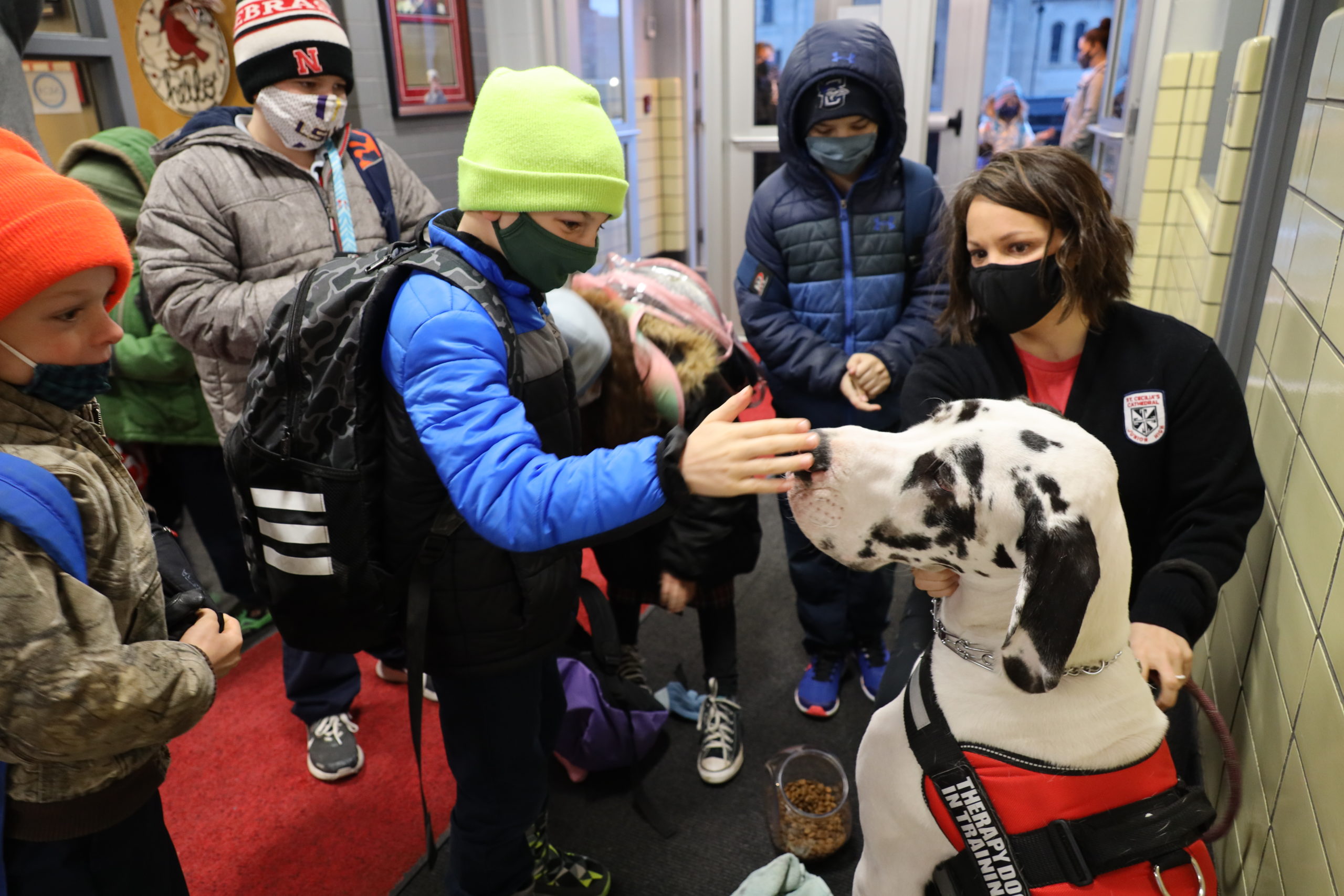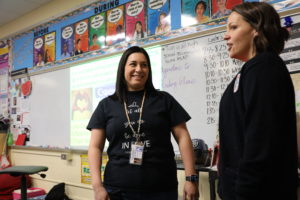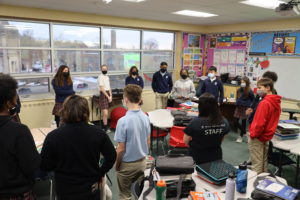
St. Cecilia School Principal Julia Pick and her 10-month-old Great Dane, Cooper, greet students at the beginning of the school day Jan. 19. MIKE MAY/STAFF
News
Student mental health the focus of St. Cecilia School initiatives
January 27, 2022
This month, the Catholic Voice salutes archdiocesan Catholic schools and those operated by religious orders as we prepare to observe Catholic Schools Week Jan. 30 through Feb. 5. With the theme “Catholic Schools: Faith, Excellence, Service,” the nationwide effort recognizes and celebrates the achievements of our Catholic schools and the valuable contributions they provide to young people, as well as our Church, communities and country.
This article is the fourth of several planned for this month to highlight some of the people and programs that make Catholic education special. Check back for more stories next week.
There is no shortage of smiles when St. Cecilia School Principal Julia Pick brings her 10-month-old Great Dane, Cooper, to school on Friday mornings.
“Oh, my goodness, the kids LOVE Cooper and Cooper loves visiting classrooms and going to PE – that’s his favorite class,” Pick said.
Pick is training Cooper to be a therapy dog. The presence of such animals in schools has been shown to reduce student anxiety and stress and provide companionship for those who may be having a difficult time with friendships, she said.
“We have already seen, for some kids who have tough mornings, that when Cooper is there, they give a quick hug to Mom and then they come right in to color in my office. They just talk to him about their morning and how they feel about the day,” Pick said, adding, “Cooper is a great listener!”
Cooper is just one part of a larger student wellness initiative taking place at the Omaha grade school, anchored by its Social Emotional Learning (SEL) program, and on-site counseling services provided by Catholic Charities.
SEL is a concept introduced 26 years ago by Chicago-based CASEL, the Collaborative for Academic Social and Emotional Learning, and is a teaching philosophy that aims to help children manage their feelings and show empathy for others.
The school began piloting the program in the fall of 2019, and adopted it permanently the next school year.
BUILDING RELATIONSHIPS
“Our focus is on building relationships with students, to build a good rapport and create a learning environment where all students feel accepted and heard,” said Liz Loehr, a middle school reading teacher spearheading the effort at St. Cecilia.

Middle school teacher Liz Loehr, left, and Julia Pick, principal, chat in Loehr’s classroom. MIKE MAY/STAFF
Through SEL, students are taught self-awareness, self-management, responsible decision making, relationship skills and social awareness, she said.
SEL teaches children the knowledge, attitudes and skills needed to understand and manage emotions, set and achieve positive goals, feel and show empathy for others, establish and maintain positive relationships, and make responsible decisions, Loehr said.
The 295 students at St. Cecilia are provided opportunities to cultivate, practice and reflect on social and emotional competencies in ways that are developmentally appropriate and culturally responsible, Pick added.
This includes meetings at the beginning of each day in which students reflect on a topic that might include a discussion of how a saint would handle the situation.

Eighth-grade students participate in their morning meeting, a part of the SEL program, where they discuss a certain topic provided by the teacher, and take part in relationship building or community building activities. MIKE MAY/STAFF
“We want to teach kids the Good News of Jesus, to embrace forgiveness, compassion and empathy, and this is just one more tool to bring those concepts forward in a meaningful way,” Pick said.
At the beginning of each school year, using SEL concepts, teachers and students outline expectations for classroom behavior together, with students given ownership of their own behavior and the responsibility to recognize when they misbehave.
Today, Pick said, she is seeing an improvement in student behavior since the introduction of SEL.
“The past two school years have seen our lowest in office referrals and suspensions and I am confident our students are finding the resources they need,” Pick said.
ON-SITE COUNSELING
To supplement the benefits of SEL, the school also partners with Catholic Charities to provide on-site counseling to students who need individual help with stress, anxiety, depression or other struggles.
Catholic Charities has provided those services since the fall of 2020, when the school returned to in-person learning.
Before the pandemic, Pick said, there were children who already struggled with anxiety, homework, conflict resolution and making friends.
Since the start of the pandemic, she has seen an increase in anxiety in students at all grade levels, highlighting the need for more mental health support at the school, in addition to the SEL program.
Emily Jamber, a therapist with Catholic Charities, provides counseling services to St. Cecilia once a week, where she typically sees about six kids who are dealing with issues ranging from depression and anxiety to loss of focus. All of these have become more pronounced since the start of the pandemic, she said.
“As a counselor, one of the most important things we teach students is how to identify and understand their emotions and how to self-regulate those emotions, especially when they interact with others,” Jamber said.
For example, the Catholic faith teaches that God wants us to be kind to one another, but in order to be kind to your neighbor you have to learn to be kind to yourself, she said.
When fifth-grader Alison Gaines, 10, is having a hard day she turns to Jamber for counseling help to work through her problems.
“She helps me look at the positives and not just the negatives, and she has taught me that I have grit, that I can’t give up on things, even when it’s hard you’ve got to move ahead and you will get through it,” Gaines said.
COMMUNICATION IS KEY
Jamber said her services fit in well with the school’s SEL program. “Implementing SEL is one of the most proactive things a school can do,” providing students the opportunity to explore their own emotions in a safe environment, Jamber said.
Jamber said one of the best things that comes from the SEL program is how to communicate effectively.
“With communication you have to understand yourself, understand your own responses, and once you understand that, then you can communicate your emotions effectively with others, paving a way for effective dialogue that comes in handy throughout life,” she said.
Alison’s sister Anna Gaines, 9, said her fourth-grade class has used the SEL “talking circle concept” in which the students sit facing one another to address conflicts among students in the classroom.
“Sometimes the boys who like to play football during recess will be arguing in the hallway on the way back inside about who won the game and Ms. Guinn will talk to us about what happened and how it can stop, or other classmates will speak up and say, ‘it’s OK, don’t fight,’ and try to make peace between them,” she said.
It gives the whole class a chance to take part in helping to resolve the conflict, the younger Gaines said.
Another common behavior across all grade levels that teachers often encounter in the classroom, Loehr said, is when a student gets up out of their seat and walks around the classroom or talks to their neighbor during lectures.
“Through SEL we try to get the student to understand that their behavior can have an impact on the learning ability of others in the room,” Loehr said.
For younger kids, it involves helping them learn through discussing with them the appropriate time and place to have a conversation with their friends, she said.
In older students, a talking circle might be used to let students express how disruptive it is when their classmates are talking in class and how it impacts other students who may be having a hard time focusing, which takes away their ability to learn from the teacher, Loehr said.
PARENTAL INVOLVEMENT
In order to successfully implement SEL it is important for parents to understand the SEL program, Pick said, so she has made a point to include them as much as possible in the dialogue.
Pick said Catholic Charities has been helpful in providing Zoom sessions where the counselors can give presentations on various topics, including SEL.
“People wondered what SEL is, what does it mean, and does this change the discipline system that they might have historically known, like the demerit system, detention and school suspension,” Pick said.
Other questions have involved whether the SEL program includes teaching on CRT (critical race theory). “SEL is not critical race theory, which is not part of a K-12 curriculum,” she said. “There are no historical lessons, we are teaching life skills.”
It has taken time, Pick said, but the more parents are involved, the more their children come home talking about it, the more they see the fruits of SEL.
Parents are especially impressed with the restorative method that is used when there is a bigger issue between two students that requires a meeting of the students, their parents, the teacher and the principal.
“We’ve had parents take part in a restorative meeting, and they like it because they see that their child has a voice,” Pick said.
And teachers are using “cardinal cards” in the classroom instead of demerit cards, she said. This method allows teachers to catch a student exhibiting good behavior, which earns points the student can redeem for a special treat.
In the end, Pick said, children just want to know that they are loved, seen and heard, all those things are free and worth the extra investment.
“After all,” she said, “we are all children of God and as such we are called to do our best to build each other up, to love one another, and to accept one another as such.”